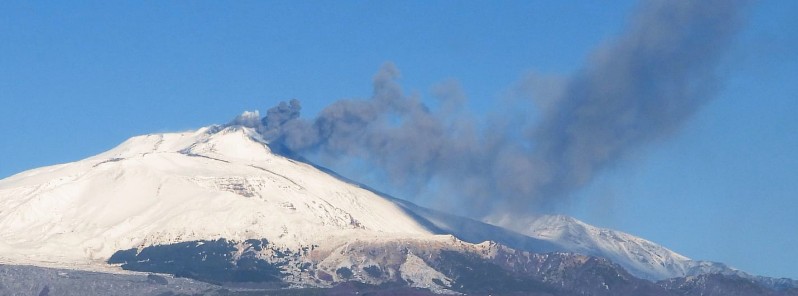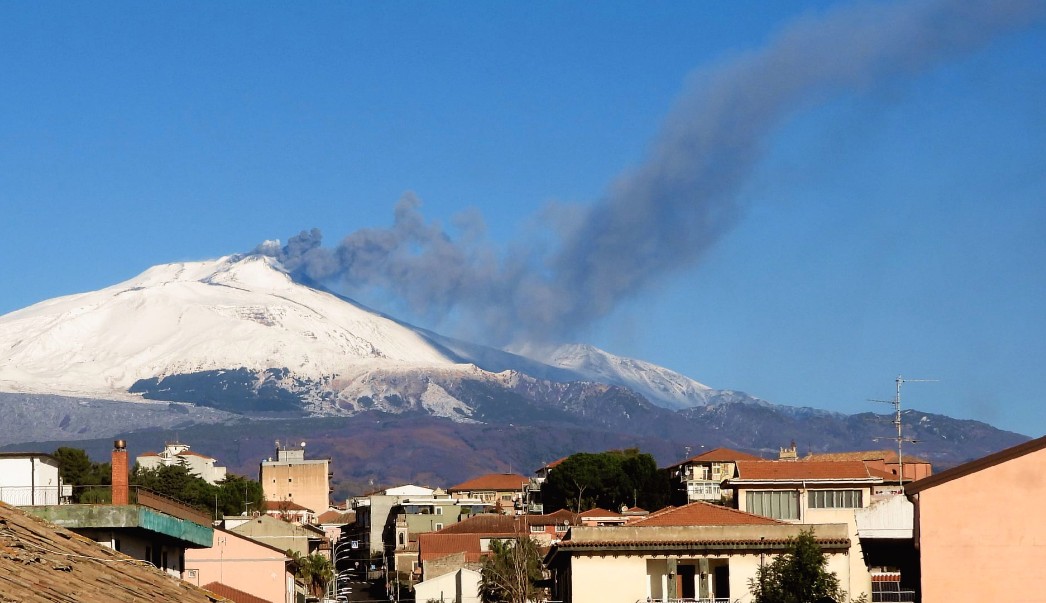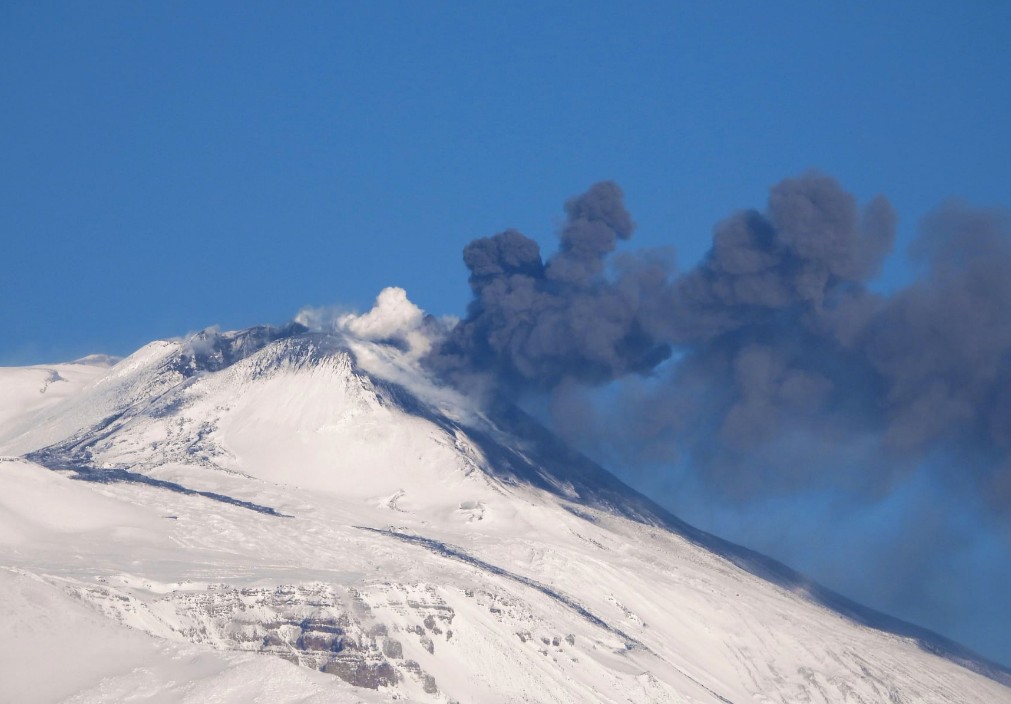Abundant dark and dense ash emission at Etna volcano, Aviation Color Code raised to Red, Italy

Volcanic activity at Etna volcano in Italy gradually intensified at around 08:00 UTC on January 4, 2021, forcing authorities to raise the Aviation Color Code to Red.
- The Aviation Color Code was raised to Red at 08:42 UTC and lowered back to Orange at 11:26 when activity decreased.
- The activity was observed by visible and thermal surveillance cameras.
INGV-OE (Etna Observatory) reports that starting at 05:45 UTC on January 4, 2020, the video surveillance network highlighted a weak and sporadic ash emission from the Voragine and Southeast Craters. The emissions quickly dispersed to the east.
Starting at 08:18 UTC today, a gradual intensification of Strombolian explosive activity has been observed at the eastern mouth of the SE Crater with abundant dark and dense ash emission, drifting eastward.
Volcanic tremor amplitude fluctuated over the past several hours, with the source in the area of SE crater between 2.8 and 3 km (1.7 – 1.8 miles) above sea level.
Strombolian activity at #Etna's Voragine (left) and Southeast craters, along with ash emission from the latter, at daybreak on 4 January 2021. pic.twitter.com/H3VpWiG8xX
— Boris Behncke (@etnaboris) January 4, 2021
30 seconds of #Etna's amazingly beautiful activity at the Southeast Crater (there was also activity at the Voragine crater, but this became visible when it got completely dark) on the evening of 3 January 2021, with some music of mine pic.twitter.com/DwLfy57HET
— Boris Behncke (@etnaboris) January 3, 2021
Infrasonic activity in the last few hours (to 09:25 UTC) has shown no significant changes. However, two increases in the number of events located at the SE, yesterday afternoon and during the night have been observed.
The localized infrasonic activity at the NE crater remains unchanged.
There have been no significant changes observed in deformation signals recorded by permanent GPS and clinometric networks.
Pictures below show ash emission seen from the town of Tremestieri Etneus on the southern side of the volcano, around 08:30 UTC on January 4, 2021.


Etna on January 4, 2021. Credit: INGV-OE
A strong explosive eruption started at the volcano on December 13, 2020, ejecting volcanic ash up to 4.8 km (16 000 feet) above sea level by 23:00 UTC. The Aviation Color Code was briefly raised to Red.
Two eruptive fissures opened on the southeastern side of the SE Crater, producing two lava flows propagating towards the S and SW, whose fronts remained confined to an altitude of about 2 850 m (9 350 feet) a.s.l. Three pyroclastic flows were observed at 22:15 and 22:16 UTC.
Surveillance cameras showed a significant decrease in explosive activity at 22:50 UTC, with variable levels over the next 4 hours.
Explosive activity decreased by 07:05 UTC on December 14.
A few moments of the second short episode of Strombolian activity culminating in lava fountaining at #Etna's Southeast Crater during the night of 13-14 December 2020. pic.twitter.com/XjVNdvIjJT
— Boris Behncke (@etnaboris) December 14, 2020
#volcan #volcano #Etna La phase paroxysmale de cette nuit (fontaines+coulées) vue de puis Paterno (sud)/The paroxysmal activity (lava fountains+flows) of the last night seen from Paterno (south) pic.twitter.com/J2iNuYNso4
— CultureVolcan (@CultureVolcan) December 14, 2020
#Etna – 14 Dicembre 2020 | Appena concluso il secondo “mini episodio” di forte attività esplosiva al cratere di sudest. In foto l’acme dell’episodio visto da Acicatena. #sicily #volcanoes #eruption
©️Photo Credit: Fabrizio Zuccarello | Tutti i diritti sono riservati pic.twitter.com/TXI7OQazeN
— EtNative (@EtNativo) December 14, 2020
La sera eruzione, la mattina bestemmione.#Etna pic.twitter.com/wgQsM8MfZ6
— Perìto "Xmas with the yours" Perària (@aedan83) December 14, 2020
Geological summary
Mount Etna, towering above Catania, Sicily's second-largest city, has one of the world's longest documented records of historical volcanism, dating back to 1500 BCE. Historical lava flows of basaltic composition cover much of the surface of this massive volcano, whose edifice is the highest and most voluminous in Italy.
The Mongibello stratovolcano, truncated by several small calderas, was constructed during the late Pleistocene and Holocene over an older shield volcano. The most prominent morphological feature of Etna is the Valle del Bove, a 5 x 10 km (5.1 x 6.2 miles) horseshoe-shaped caldera open to the east.
Two styles of eruptive activity typically occur at Etna. Persistent explosive eruptions, sometimes with minor lava emissions, take place from one or more of the three prominent summit craters, the Central Crater, NE Crater, and SE Crater (the latter formed in 1978).
Flank vents, typically with higher effusion rates, are less frequently active and originate from fissures that open progressively downward from near the summit (usually accompanied by strombolian eruptions at the upper end).
Cinder cones are commonly constructed over the vents of lower-flank lava flows. Lava flows extend to the foot of the volcano on all sides and have reached the sea over a broad area on the SE flank. (GVP)
Featured image credit: INGV-OE

Commenting rules and guidelines
We value the thoughts and opinions of our readers and welcome healthy discussions on our website. In order to maintain a respectful and positive community, we ask that all commenters follow these rules.